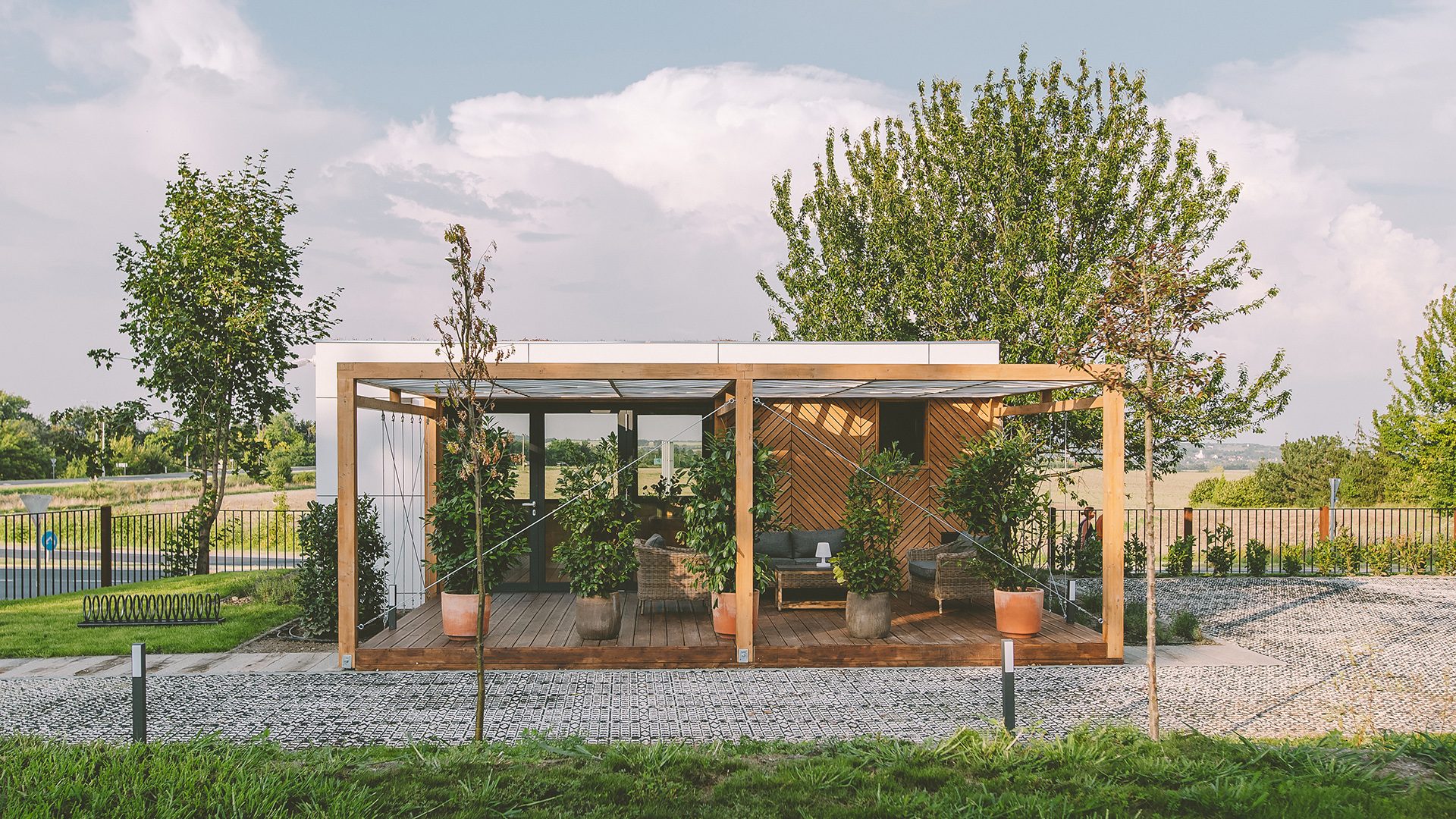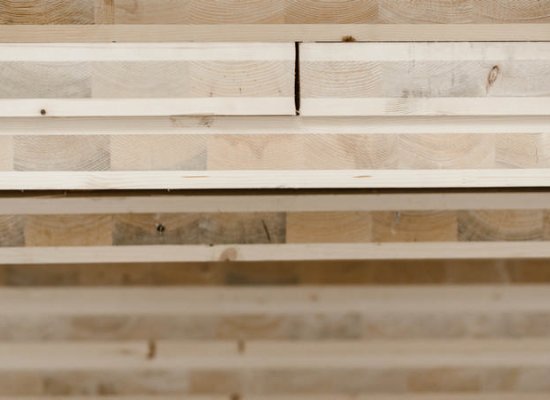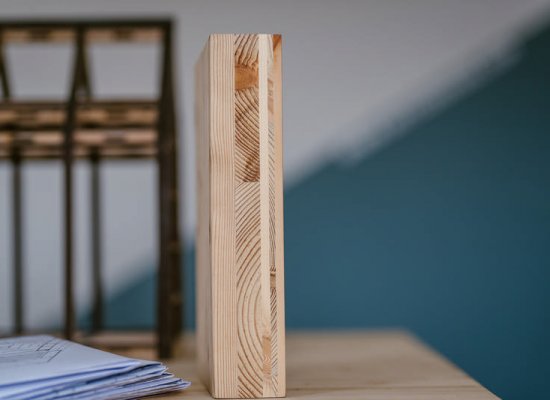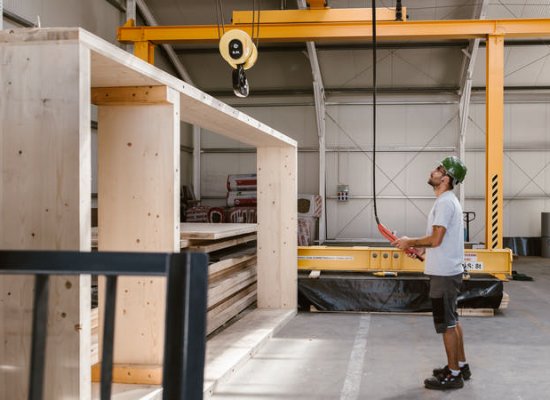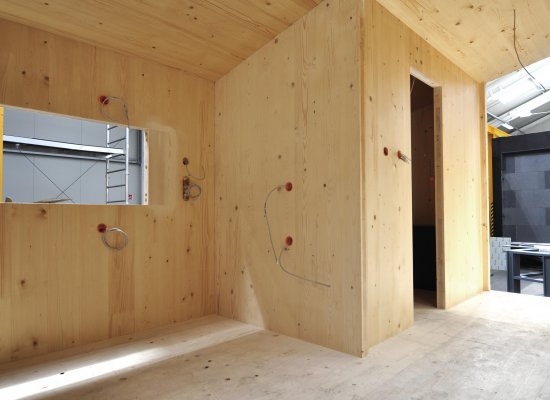Referred to as the “material of the future”, CLT/Cross Laminated Timber is a structurally rigid and durable material, that comes in large panels, made of solid wood, glued together and layered across to each other.
Similarly to plywood, the layers of the CLT panels are each rotated by 90 degrees, but the layers themselves are made of thicker, solid planks. Such a panel, processed by a CNC, can be used in many applications, i.e: any wall, ceiling, floor, or roof geometry.
Tömegének köszönhetően jó hőtároló, hangszigetelő és tűzvédelmi képességgel rendelkezik. A fa kitűnő nedvességszabályozó, így egészséges és kellemes lakókörnyezetet biztosít. Wood acts a perfect moisture controller, so that it provides a comfortable and healthy environment. The used material comes from suppliers with a PEFCTM certificate, from sustainable, and regulated forestries.
The base material is usually spruce (with a material quality of C20, C24, which indicates flexural strength), but other manufacturers also use poplar, scotch fir, or redwood. The panel size varies depending on the different companies, but usually, it 2,95m wide and 16m (20m) long. The thickness ranges from 60mm to 320mm (sometimes up to 400mm), with a layer count from 3 to 7 layers.
Large CNC machines process the ordered shapes and layouts so that a wall or ceiling can be shipped and installed in one piece. The tolerances of these machines are minimal, so building phases can be sped up, due to lack of measuring on-site.
Connections are made with screws, plates, or brackets.
Benefits of CLT:
- natural, sustainable material from responsible forest managements: CCS is made from a renewable product, making it one of the most sustainable and low-carbon building materials on the market
- provides a healthy and pleasant living environment. Wood products in the interior have been shown to improve indoor air quality by reducing humidity.
- short construction time thanks to its dry installation
- can be prefabricated to supreme quality within factory conditions
- visible wood surfaces can also be achieved with CLT
- precise and efficient construction technique, can be installed regardless of weather or temperature conditions. Its use does not involve a large amount of dirt, as in a conventional constructions, and is a much less noisy (and stress-free).
- excellent structural quality
- excellent shape and dimensional accuracy and retention
- remarkable fire resistance: wood in large masses, does not easily ignite and even is if so, the wood burns slowly, in a predictable pace. Comparing a glulam beam to steel, the steel beam failed after 30 minutes, however, the wooden beam retained 70% of its structural integrity.
- from three layers, the structure is considered air-tight
- due to its thermal capacity, the fluctuation of the outside temperature is mitigated in the inside, in a way that the maximum values of these temperatures are offset in time
- due to cross lamination, it inhibits moisture diffusion, furthermore, its dimensionally stable, not subject to swelling or shrinkage, with minimal warping.
- easy to shape, easy to install with high dimensional accuracy.
- easy to install in hard to reach places
- earthquake-resistant construction method
- natural material instead of concrete
- healthy (residents are shown to have lower stress, blood pressure and heart rate*) and provides a pleasant living environment
- reduces ecological footprint.
- cognitive abilities increase by 61% living in wood homes, and this increases up to 101% if additional ventilation functions are introduced.
- as a natural resource, wood is non-toxic, safe to handle and touch; naturally ages and does not decompose to environmentally harmful substances.
- can be treated with coatings that make it easier to clean the surface, avoiding the spread of infections.
- excellent moisture control – hygroscopic material
- comfort awareness
- larger open interiors can be created, up to 10% more living space can be achieved using CLT (compared to the average housing of 1000 sq ft)
- no limit on size.
- suitable for multiple story constructions and multiple relocations
Data and figures
Due to the versatility of wood, CLT technology is constantly evolving, so a lot of research and development results are coming to light every day, which also support the advantages described above:
- The speed of building with wood is confirmed by the construction of a complete 18-storey CLT university building in Canada that was built in 9 1/2 weeks. All it took was nine workers. In Veresegyház, Hungary, a 312m2 family home was erected by 5 workers in 10 days.
- Research confirms that a square metre of steel beam material emits 40 kg of carbon dioxide and requires 516 megajoule of energy during its making. Concrete is not much better: since the same amount emits 27 kg of carbon dioxide and requires 290 megajouls of energy. In contrast, a square metre of wood space emits only 4 kg of CO2 and requires only 80 megajoules of energy. In other words, if square meters of land are built from wood instead of steel, the original emissions will be reduced by 90%.
- Technology can be used to make the building earthquake-resistant. If the building is built in an earthquake-threatened area, individual wooden elements are reinforced with screws and nails. In the event of an earthquake, they act like a shock absorber and significantly reduce seismic forces, making the building earthquake-resistant.
Carbon friendship, climate protection
The issue of environmental awareness is also raised in relation to architecture, which increasingly leads the way, and its importance is not negligible. The European Union’s ambition to become fully climate neutral by 2050 is also supported by Hungary. What does that mean for architecture? The main cause of global warming, which has been discoverable since the mid-20th century, is the increase in the concentration of greenhouse gases in the earth’s atmosphere. 76% of greenhouse gases entering the atmosphere are carbon dioxide. More than a quarter of these gases come from the construction industry or from the production of raw materials used in the construction industry. Using CLT, you can achieve not only a reduction in CO2 emissions, but also carbon neutrality, i.e. the building with zero greenhouse gas emissions throughout its life cycle, i.e. zero carbon footprint.
Not only the construction, but also the production of CLT is a green technology, as it imposes a negative burden on air pollution. As they grow, trees absorb carbon dioxide in the atmosphere, releasing oxyge, and storing the remaining carbon. Dry wood is 50% carbon. The carbon is thus deductible from the carbon footprint. Even after a possible deconstruction, it can be easily recycled and no pollutants are discharged into nature during or after demolition.
Currently, compared to annual logging in the world, the annual increase is only 20% of the whole timber production. Increasing this rate to 34% would avoid 14-31% of global co2 emissions from steel and concrete and reduce global fossil fuel use by 12-19%. Wooden buildings significantly reduce greenhouse gas emissions, reduce fossil fuel consumption and protect forests thanks to eco-conscious extraction.

